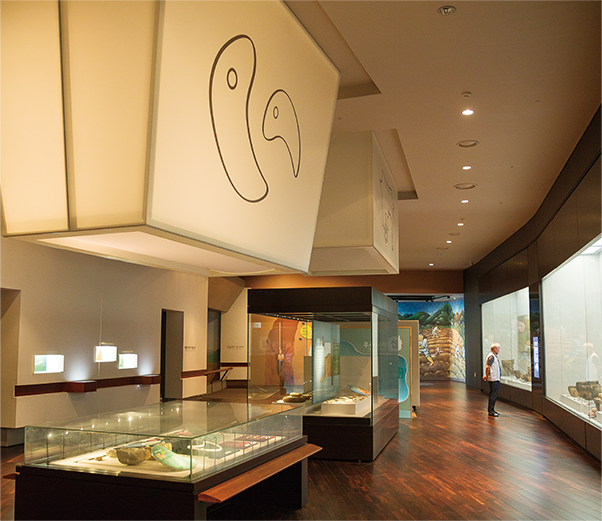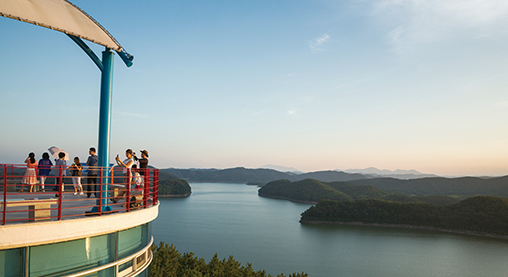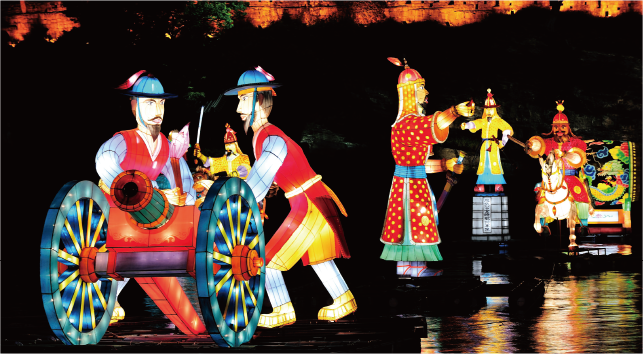Near the bottom of the southern region of the Korean peninsula isthe historic city of Jinju with a population of 350,000.Flowing through the heart of the city is the Nam River. In the past it wasthe scene of wretched battles when the Japanese invaded and in modern timesit was dammed to form Jinyang Lake. In Jinju, time flows with the water.
Sitting by a window overlooking the lake, I read a young poet’s first anthology. Poetry, water and travel are all very similar in nature. Water quietly flows over the land and then stops, just as poetry flows through the spirits of human beings and stops at some point. Travel is a way for people to flow through time. When people stop traveling and lie down to rest for a moment, that’s when their hearts grow warm.
Naechon is a village by Lake Jinyang. I’m fortunate in being able to start my travels here. I sit inside a café and look out the window, turning over the pages of the poetry book.
At the traditional market in the city where I live, a young couple opened a bookstore named Simda. The word means “to plant,” as in “to plant trees” or “to plant flowers.”
“Who’s going to come to the market to buy books? I hope you don’t end up starving to death.”
The market merchants worried for the couple, but their concerns have turned out to bring good tidings. People began to seek out the little bookstore which is no bigger than 10 square meters. Tourists getting off at the nearby train station would make their way through the narrow market aisles to find it. Some came to read the travelogues, poetry books and picture books on display in the tiny bookstore. Television folks and journalists also came.
Did Bronze Age Humans Have Poetry?
When I stopped by the bookstore on my way to Jinju, the owners handed me a volume of poetry. “Dam Dam.” A mind as peaceful as flowing water ... It is the first poetry anthology by Chang Sung-hui. While reading the book, deep inside me I sensed the no small turmoil and misfortune experienced by the author in her life.
The downtown area is seen beyond the railings of Chokseongnu on a bank of the Nam River, which flows through the city of Jinju. First erected in the Goryeo Dynasty, the pavilion has been rebuilt and repaired many times over the years. During the Japanese invasions of 1592–1598, it served as command headquarters for the defense of Jinju Fortress and today is a province-designated cultural property that is popular with local residents as a place to stop and take a rest.
A day when I was sick and alone
I melted in the cold and lost all form.
I am a sham.
I press down my feet wet from walking so long
In square shoes
My beloved coldness spilling down, down
As my high heels click noisily.
The long names I could not soon give up
Remain thick on my tongue.
This is a poem titled “Ice.” I liked the way ice is used as a metaphor for tears. The“My beloved coldness” is also a metaphor for tears. Also, my eyes are caught by the “square shoes.” Surely, life is like endlessly groping in the air wearing a pair of square high heels. The water on the lake is tranquil.
I drive along Route No. 1049 following the lakeside. After about 10 kilometers, I see a sign pointing to the Jinju Bronze Age Museum. The museum is dedicated to exploring the lives of the people who settled in the delta here around 1,500 B.C., and displays relics from that time.
I drive along Route No. 1049 following the lakeside. After about 10 kilometers, I see a sign pointing to the Jinju Bronze Age Museum. The museum is dedicated to exploring the lives of the people who settled in the delta here around 1,500 B.C., and displays relics from that time.

The Jinju Bronze Age Museum features an exhibition of relics excavated from the Daepyeong-myeon area in Jinju.
How did they live, those people from 3,500 years ago? At the museum, I read that some 400 pit dwelling sites had been discovered in the area and was amazed to see that the food, clothing and shelter of the Bronze Age people were not so different from ours today. They ate rice cooked in earthenware pots over a fire and grilled fish caught in the river. Carbonized peach pits were also discovered. I looked at a kitchen loft where grains were stored, a weight used for spinning thread and dark red pottery dishes.
Suddenly I wondered how the people back then expressed the flow of their thoughts, whether they dreamed of crossing mountains and rivers and traveling about. I closely examined the surface of the pottery vessels and noted that they were all undecorated.
For the people who lived here 3,500 years ago, poetry certainly did not yet exist. Also, traveling alone was probably impossible. The notion that humankind is the lord of all creation is likely a conceit born of the intellectual arrogance or narcissism of humans regarding the civilization they have d in modern times.
Aesthetic Language of Unfortunate Times
I get back on the same road and continue driving. The mimosa trees lining the lakeside are in full bloom. In Korean, these trees are called haphwansu (“joyously united tree”) or haphonmok (“twilight united tree”). The fern-like leaves open out along the twigs during the day, but when the sun goes down they fold up over each other. Under the shade of a mimosa on a hillside with a view over the lake, I take out the poetry book and start reading again.
The gods and wine
These names I held to be safe antidotes.
Though winter is gone my breath is white,
My body yearns for the grave.
This warlike weather, how much hotter can it get
A question mark attached to every breath.
The wind blows and the rain falls
Walking without an umbrella
You are like the shade of a fallen tree.
The above poem is titled “Though Walking Without End.” The person walking without an umbrella is the poet herself. In the 1980s, which were like the shade of a fallen tree, I was in my twenties and “the age of poetry” had arrived in Korea. Through political oppression and persecution people wrote poetry. Farmers, carpenters, bus drivers, steelworkers, teachers, miners, nurses — everyone wrote poetry. Poetry was solace for people and a haven for their spirits. Poetry volumes that sold a million copies were published one after another. And the people loved that period.
To the young poet who wrote “Dam Dam”: Do not despair. You have your beloved language at your side and the day will come when you record in whole the sadness and beauty of the human spirit.
I thought thatpoetry dwells inthe hearts of peoplein pain, and thatit embodiesthe journeys ofsuffering spirits.For a moment,I wonderedwhether the BronzeAge people of3,500 years agohad no poetrybecause theyknew no pain.
The Heart Redder than the Poppy

At the Jinyang Lake Observatory, visitors look out over the water to enjoy the scenic view at twilight.
Chokseongnu is a stately pavilion inside Jinju Fortress. To Koreans, this beautiful structure standing over a bend of the Nam River is both a living reminder of their painful history and an enduring consolation.
In 1592, the Japanese invaded Joseon. The wars that raged for the next seven years are known as the Imjin Waeran. When the Japanese forces, consisting of 20,000 soldiers, attacked Jinju Fortress in the tenth month of that year, Kim Si-min, the magistrate of Jinju, defeated them, leading a force of just 3,800. By the end of the seven-day battle, the Japanese had lost 300 commanders and 10,000 soldiers, which gives an idea of the wretchedness of the war. Kim Si-min was shot and died in the battle at the age of 39.
The second battle at Jinju Fortress began in the sixth month of the following year. The war was waged amid monsoon rains and ended with the fall of Jinju Fortress. All the Joseon soldiers inside the fortress died either fighting the Japanese or by jumping into the Nam River, and the civilians sheltering within the fortress were slaughtered. The Japanese sent as many as 20,000 severed heads of Koreans back to their country. It is said that the bodies of those who had drowned blocked the flow of the river. Although the city had fallen, the Japanese suffered great losses and failed to occupy the Honam region to the west, the granary of the country, eventually forcing them to give up their ambitions of conquering Joseon. Hence the profound significance of the battle.
From this historic battle, the story emerged of a woman who bloomed like a flower after the war. Nongae is known as a gisaeng, an artistic entertainer, although some records say she was simply a commoner. However, her social position is not important. After the Second Siege of Jinju, the Japanese soldiers held a victory banquet, with several gisaeng in attendance. At the party, Nongae enticed the enemy commander, Keyamura Rokusuke, to the edge of a cliff, wrapped her arms around him and jumped to their death into the Nam River below. Locals call the rock from which Nongae jumped Uiam (Rock of Loy alty), while the shrine dedicated to her memory is called Uigisa (Shrine of the Loyal Gisaeng) and stands overlooking the river. The poet Byeon Yeong-ro memorializes Nongae:
Under the Jinju Fortress walls is a street full of antiques, stretching 600 meters, that is named Insa-dong. Antique stores began to appear here one by one in the 1970s and the street looks much the same today.
Noble anger
Is deeper than religion,
Fiery passion
Is stronger than love.
Ah! Over the water
Bluer than the pea flower,
Flows a heart
Redder than the poppy.
The beautiful sleek eyebrows
Quiver up high
And the pomegranate lips
Kissed death!
Ah! Over the water
Bluer than the pea flower,
Flows a heart
Redder than the poppy.
The October Lantern Festival, held in honor of those who died in the wars of resistance against the Japanese invasions, is the pride of the people of Jinju. In recognition of the unique story behind the festival, the International Festivals and Events Association (IFEA) in 2015 granted Jinju the World Festival and Event City Award.
When the festival begins, the Nam River is covered with brilliantly colored floating lanterns. At night, the heavens seem to be filled with more paper sky lanterns than stars, recalling the Siege of Jinju, when defenders and civilians caught inside the walls used such sky lanterns to give news of their situation to those outside, while people outside sent news from home to those inside.
A visit to Jinju in early October rewards the traveler with magnificent scenery and may bring unexpected joy. You can write your name and your dreams and wishes on a lantern and send it soaring into the night sky. Then, who knows — how those lanterns must have raised the spirits of the people of Jinju, carrying their hearts’ wishes and pleas to the heavens during those cold and desperate nights of 425 years ago as they confronted the invaders, with the Nam River their last defense.
A Novelist’s Beloved Antique Street

Battle scenes from the Japanese invasions are re-d every year with colorful floating lantern effigies during the October Lantern Festival, which takes place on the Nam River.
I love the old street wrapped around the fortress walls of Jinju. It’s called Insa-dong, like the famous antique alley in Seoul. And there’s someone I always think of whenever I visit this street: the late novelist Park Wan-suh.
Park loved this street. Insa-dong in Seoul is too busy and the goods are too expensive, but its namesake in Jinju is quiet and the people are still kindly and big-hearted. As Park used to say, it’s still an enjoyable place to walk around. And no wonder. The merchants there have all read at least one or two of her novels, and one brought out his copy for her to autograph. Only a writer knows how it feels to be with people who treat your work with respect.
Park was especially fond of wooden furniture from the Joseon period. “Joseon wooden items are never overwhelmed, even when they are placed with sophisticated Western paintings or abstract art. They do not lose their dignity and have the quiet presence to complement or offset still s,” she said.
Thinking of her, I browsed a number of antique stores. The shopping god grabbed me, and I bought a glazed earthenware vessel for the equivalent of three hundred dollars. If Park were here she would say, “Oh! Where did you find that? You have a wonderful eye for things.”
Where Poetry Begins, Where Poetry Belongs
The Rhee Seund Ja Jinju Museum of Art opened in 2015. Born in Jinju in 1918, Rhee was one of the painters who, along with Kim Whanki and Lee Ung-no, made 20th century Korean art known internationally.
A large number of her works in the museum bear poetic titles. Paintings with titles such as “The Texture of the Wind,” “Murmurings of Dawn” or “The Carefree Mermaid” touch and settle warmly in one’s heart. During the Japanese colonial period in the first half of the 20th century, Rhee studied in Japan, and in 1951 at the height of the Korean War, she went to study in France, a kind of displacement that certainly left its mark on her work. How could she forget the suffering of her homeland and the people left behind?
I thought that poetry dwells in the hearts of people in pain, and that it embodies the journeys of suffering spirits. For a moment, I wondered whether the Bronze Age people of 3,500 years ago had no poetry because they knew no pain. Back then, people were more compassionate and more at peace than we are today. It may be that our history as human beings who write poetry is in fact a step backward.